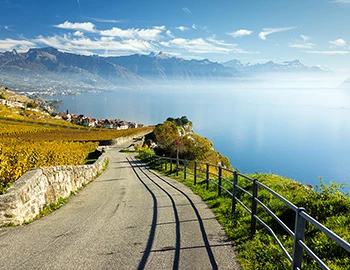Neuenburg
Neuchâtel: the Burgundy of Switzerland
Neuchâtel is considered the stronghold of the art of watchmaking. The precision that characterizes the clockwork mechanisms can also be found in many crus here, which grow on calcareous soils. The narrow strip between Lake Neuchâtel and the southern rim of the Jura Mountains is the perfect terroir for Chasselas, but also for Pinot Noirs, which present Burgundian characteristics. With the white “Non Filtré” and the indigenous “Oeil de Perdrix”, vintners in Neuchâtel have two particular specialties.
White wines from Neuenburg
White wines from Neuenburg
Rosé wines from Neuenburg
Rosé wines from Neuenburg
Neuchâtel is one of Switzerland’s oldest vinicultural regions. A document dating from 998 describes the right of the Bevaix Abbey to plant grapes. Thus Neuchâtel shares many similarities with Burgundy aside from the terroir. As elsewhere, it was monks who established viticulture here. And, similar to the legendary Hospice de Beaune, Neuchâtel also has a traditional winery in its L’Hôpital Pourtalès, whose income serves charitable purposes.
Refreshing “Non-Filtré”
Chasselas and Pinot Noir set the tone for Neuchâtel. Of the total of around 600 hectares planted with vines, roughly 500 are accounted for by these two varieties. The typical Neuchâtel Chasselas has a fascinatingly fresh, straightforward character. One particular specialty is the “Non-Filtré”: for 40 years, vintners have filled a portion of their Chasselas turbid – before final filtration, but fully fermented – bringing this young wine to the market every third Wednesday of January. Pinot Noirs also rank among the most elegant and delicately fruity in all of Switzerland. The Oeil de Perdrix also originates in Neuchâtel. The wine, whose colour is reminiscent of a partridge’s eye, is vinified from Pinot Noir grapes after only short maceration. It is a straightforward, refreshing rosé. Unfortunately, Neuchâtel wineries have failed to protect the name of this wine, so it is now produced across the whole of Switzerland.
Sparse soils - elegant wines
It is the terroir that give the Neuchâtel crus their particular finesse. The Jura soils are very low in humus, but the same time are extremely rich in lime and mineral salts. In the east and centre of the wine region, the soils are also rich in stone, and marl proportion is higher in lower locations. It is these sparse soils that lend the wines the minerality that enthusiasts particularly esteem. The mild maritime climate with good air circulation and moderate annual rainfall of 980 millimetres per year per square metre, provides ideal conditions for cultivating sophisticated wines.







